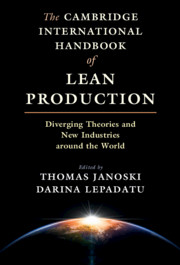 The Cambridge International Handbook of Lean Production
The Cambridge International Handbook of Lean Production Book contents
- The Cambridge International Handbook of Lean Production
- The Cambridge International Handbook of Lean Production
- Copyright page
- Dedication
- Contents
- Tables
- Figures and Sidebars
- Preface
- Acknowledgments
- Contributors
- Abbreviations
- 1 Lean Production as the Dominant Division of Labor
- Part I Theories of Lean Production
- Part II Lean Production across Industries
- Part III Lean Production Around the World
- 17 Lean in Europe and the USA – A New Dominant Division of Labour?
- 18 The Development and Diffusion of the Hyundai Production System
- 19 Transferring Lean to the United States
- 20 Disseminating Lean across the UK: A Personal Reflection
- 21 Lean Production in Germany
- 22 Tricolore
- 23 Lean Production in China: A Case Study of the Automobile Industry
- 24 Lean Production in India and Australia
- 25 The Four Stages of Lean in Mexico
- 26 Lean Production in Post-Communist Europe
- Name Index
- Subject Index
- References
19 - Transferring Lean to the United States
from Part III - Lean Production Around the World
Published online by Cambridge University Press: 11 March 2021
- The Cambridge International Handbook of Lean Production
- The Cambridge International Handbook of Lean Production
- Copyright page
- Dedication
- Contents
- Tables
- Figures and Sidebars
- Preface
- Acknowledgments
- Contributors
- Abbreviations
- 1 Lean Production as the Dominant Division of Labor
- Part I Theories of Lean Production
- Part II Lean Production across Industries
- Part III Lean Production Around the World
- 17 Lean in Europe and the USA – A New Dominant Division of Labour?
- 18 The Development and Diffusion of the Hyundai Production System
- 19 Transferring Lean to the United States
- 20 Disseminating Lean across the UK: A Personal Reflection
- 21 Lean Production in Germany
- 22 Tricolore
- 23 Lean Production in China: A Case Study of the Automobile Industry
- 24 Lean Production in India and Australia
- 25 The Four Stages of Lean in Mexico
- 26 Lean Production in Post-Communist Europe
- Name Index
- Subject Index
- References
Summary
The ideas that eventually became known as “lean production” were fully developed and implemented at Toyota in Japan by the late 1960s. And they were transferred to a few export-oriented manufacturing companies in Japan by this date as well. But their transfer to the USA awaited both a need and a means.
- Type
- Chapter
- Information
- The Cambridge International Handbook of Lean ProductionDiverging Theories and New Industries around the World, pp. 467 - 489Publisher: Cambridge University PressPrint publication year: 2021


